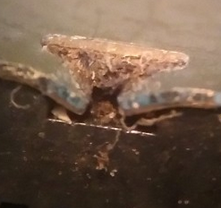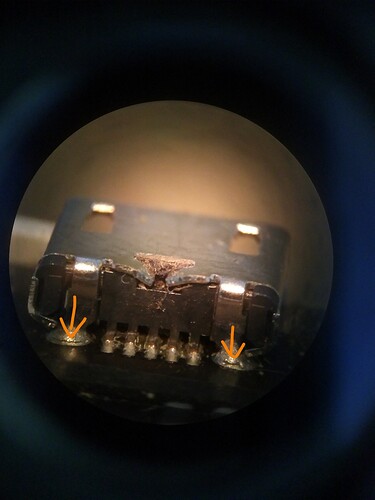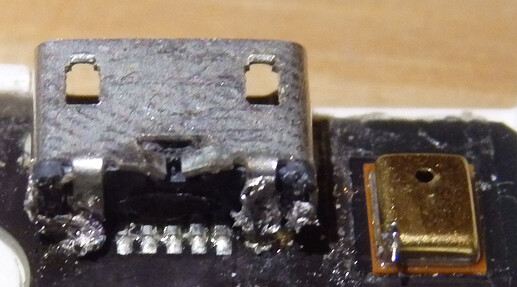@JohnHughes (thanks again) send me two broken bottom Modules some days ago. This one has a defekt µUSB port.
After disassembling I took a picture with a microscope camera and found some solder cracks. Barely to see without magnification. Two cracks at the shield contacts that I am not too worry about, but also one at contact 5. I am sure that was a slack joint. Some serious force must be acted to the Port.
I will try to resolder the joints and hope the bottom module will be able to do its work again.
So my solder tip is way to big for these pretty small joints. So I will not get the first price at the beauty contest =) Next time I need a hot air solder station.
Later I will give it a try and perform a funktion test on my FP2.
Tested it yesterday. Charging works again. Sadly the microphone is also broken :-/ I need to research where to get these.
Hey great to see modules beeing repaired!
Because often it is possible with the right tools and some training.
Hot air is a very good idea.
I used several times a hot air gun (but digital controlled) and it worked well.
But have a closer look at the left solderjoint.
The pad is connected to a large GND area that conducts the heat away from your soldertip.
Notice the small waves on the surface. Seems like the solder wasn’t completly liquid.
Patrick
Yes your are right, the solder wasn´t as liquid as it shold be. In all edges of the USB connector there is a connection to GND, so it ist just an esthetic poit of view. And the connector works well again. I will have a look after the broken mic, but first I need some vacation. =)
Some time went by. Last week I found some time to search for a spare SMT mic. I barely could read what is written in the mic:
S1655
4617
Sadly a google search does’t gave me usable results.
So a question to the community: Does anyone know, what manufacturer(s) for the microphone is/are used?
I would order some parts, If I get to know it and would start to repair the bottom modules.
I would be really surprised, should that be a MEMS microphone you can buy online as a spare part.
In that list from 2015:
it’s not mentioned and I did not happen to find any later one.
As I am not into microelectronics, I wouldn’t happen to know, if there are differences in the layout or if you could use any other mic to be available on aliexpress, amazon, ebay or the like.
Hey,
you can get quite some parts from mouser.com or digikey.com. But you need information about the parts.
It would be super nice if we can get some BOMs of the modules 
The question is where can we get those?
In the meantime we can get two broken modules and make a working one.
Maybe some have a loose USB connector and some have a broken microphone.
(most likely more broken USBs  )
)
Have done some search again and happened to find that shop for spare parts:
Of course Fairphone is not listed on that page. But maybe a compatible one can be found.
When you look at the microphone-pictures, you can see numbers printed on them, but those numbers are not given anywhere, so I doubt they are any good for searching. 
I guess that “how to” for replacing a microphone is nothing you need, but maybe it’s helpful for someone … 
Hey,
just desoldered my microphone from the bottom module.
the (very thin) pcb is glued into the plastic case of the module. But with a heatgun the glue softened and you can pull it out.
After that I put my heatgun on 380°C and desoldered the mic. I coverd the surrounding parts with kapton tape.
But I ripped one half of one solderpad off the pcd(see picture, top right pad). The trace from that pad seemed to be connected to a via next to it.
That was written on my mic:
S1263
2779
unfortunately I dropped the mic on the floor and couldn’t find it easily 
I will search it next week probably… 
In the next days I will post small sketch of the dimension of the mic-footprint.
cheers,
Patrick
Jep, that happens easily with surface mounted devices. You can try to scratch away the black coat on the line and place the mic a little bit shifted to the scratched side. For a good soldering result you should use soldering paste on the solder pads.
Happy soldering 
And please tell us about the result.
This topic was automatically closed 182 days after the last reply. New replies are no longer allowed.
Reopened this topic as there is more demand for DIY repair for FP2 bottom modules.
Hey @ElKrasso, thanks for these great photos!
I have here a bottom module with a non-functional micro-USB port, and I thought it might be the same. I observed the port through a binocular loupe. See the result:
(sorry for the lousy photo, it was taken by my FP2)
It seems it is full of dirt (which couldn’t be seen without magnifying), but there are also two cracks, shown by the arrows. The don’t seem to severe to me. What do you think? I can try resoldering them, though I think my tip is also way too big and I don’t have soldering skills as good as yours.
Hallo Alex,
on the photo the cracked solder joint are obvious. But these are only for the shield and on both sides are additional ones.
I can not see cracked data or power conatcts. I would just resolder all contacts and give it a try. Maybe you solve the issue just with that. It is worth the try and enhance your solder skills 
Is it just me, or does it look corroded at the top in the middle.
If so, it seems that the “opening” there might result in corrosion on the inside as well.
Still, worth a try and a good practice in soldering.
![]()
Do you mean here:

It seems to be dirt, or rather lint, I’ll have to clean it.
I had cases of compessed dirt, which prevents the plug to connect correctly to the contacts. So the charging progress was very slow or only possible when bending the plug into the socket.
I took time last week to resolder the µUSB port!
Don’t worry about this, I get the first price at the ugliness contest!
At first when I tried it, it didn’t work. I wasn’t too surprised.
Then today I tried it out again. And surprise… it worked!!! ![]() I had to nudge it a bit before it accepted to charge and to be recognized by adb, but it actually worked! Now, I can’t be sure whether it’s the soldering or the dismounting that helped, though I would tend to say the soldering.
I had to nudge it a bit before it accepted to charge and to be recognized by adb, but it actually worked! Now, I can’t be sure whether it’s the soldering or the dismounting that helped, though I would tend to say the soldering.
Only negative which I saw only after having remounted everything: I let a bit of tin on the mic (as you can see on the photo), and it seems to interfere with the recording sometimes (but the mic still works). I may have a look at it to remove it sometime.
Even though it was probably out of luck, I repaired my first bottom module. Let me be proud.
And we know where the mic is now, so that’s a bonus 

